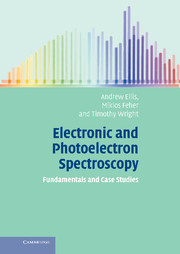Book contents
- Frontmatter
- Contents
- Preface
- List of journal abbreviations
- Part I Foundations of electronic and photoelectron spectroscopy
- Part II Experimental techniques
- Part III Case Studies
- 13 Ultraviolet photoelectron spectrum of CO
- 14 Photoelectron spectra of CO2, OCS, and CS2 in a molecular beam
- 15 Photoelectron spectrum of NO–2
- 16 Laser-induced fluorescence spectroscopy of C3: rotational structure in the 300 nm system
- 17 Photoionization spectrum of diphenylamine: an unusual illustration of the Franck–Condon principle
- 18 Vibrational structure in the electronic spectrum of 1,4-benzodioxan: assignment of low frequency modes
- 19 Vibrationally resolved ultraviolet spectroscopy of propynal
- 20 Rotationally resolved laser excitation spectrum of propynal
- 21 ZEKE spectroscopy of Al(H2O) and Al(D2O)
- 22 Rotationally resolved electronic spectroscopy of the NO free radical
- 23 Vibrationally resolved spectroscopy of Mg+–rare gas complexes
- 24 Rotationally resolved spectroscopy of Mg+–rare gas complexes
- 25 Vibronic coupling in benzene
- 26 REMPI spectroscopy of chlorobenzene
- 27 Spectroscopy of the chlorobenzene cation
- 28 Cavity ringdown spectroscopy of the a1Δ ← X3Σ–g transition in O2
- Appendix A Units in spectroscopy
- Appendix B Electronic structure calculations
- Appendix C Coupling of angular momenta: electronic states
- Appendix D The principles of point group symmetry and group theory
- Appendix E More on electronic configurations and electronic states: degenerate orbitals and the Pauli principle
- Appendix F Nuclear spin statistics
- Appendix G Coupling of angular momenta: Hund's coupling cases
- Appendix H Computational simulation and analysis of rotational structure
- Index
- References
14 - Photoelectron spectra of CO2, OCS, and CS2 in a molecular beam
Published online by Cambridge University Press: 05 June 2012
- Frontmatter
- Contents
- Preface
- List of journal abbreviations
- Part I Foundations of electronic and photoelectron spectroscopy
- Part II Experimental techniques
- Part III Case Studies
- 13 Ultraviolet photoelectron spectrum of CO
- 14 Photoelectron spectra of CO2, OCS, and CS2 in a molecular beam
- 15 Photoelectron spectrum of NO–2
- 16 Laser-induced fluorescence spectroscopy of C3: rotational structure in the 300 nm system
- 17 Photoionization spectrum of diphenylamine: an unusual illustration of the Franck–Condon principle
- 18 Vibrational structure in the electronic spectrum of 1,4-benzodioxan: assignment of low frequency modes
- 19 Vibrationally resolved ultraviolet spectroscopy of propynal
- 20 Rotationally resolved laser excitation spectrum of propynal
- 21 ZEKE spectroscopy of Al(H2O) and Al(D2O)
- 22 Rotationally resolved electronic spectroscopy of the NO free radical
- 23 Vibrationally resolved spectroscopy of Mg+–rare gas complexes
- 24 Rotationally resolved spectroscopy of Mg+–rare gas complexes
- 25 Vibronic coupling in benzene
- 26 REMPI spectroscopy of chlorobenzene
- 27 Spectroscopy of the chlorobenzene cation
- 28 Cavity ringdown spectroscopy of the a1Δ ← X3Σ–g transition in O2
- Appendix A Units in spectroscopy
- Appendix B Electronic structure calculations
- Appendix C Coupling of angular momenta: electronic states
- Appendix D The principles of point group symmetry and group theory
- Appendix E More on electronic configurations and electronic states: degenerate orbitals and the Pauli principle
- Appendix F Nuclear spin statistics
- Appendix G Coupling of angular momenta: Hund's coupling cases
- Appendix H Computational simulation and analysis of rotational structure
- Index
- References
Summary
Concepts illustrated: supersonic expansion cooling; adiabatic and vertical ionization energies; vibrational structure in the spectra of triatomic molecules; Franck–Condon principle; link between photoelectron spectra and molecular orbital diagrams.
A severe restriction of conventional photoelectron spectroscopy is its low resolution. The main limitation is instrumental resolution, particularly that caused by the electron energy analyser, as was discussed in Chapter 12. Resolving rotational structure is not a realistic prospect for conventional photoelectron spectroscopy but even vibrational structure may be difficult to resolve. In addition to the instrumental resolution must be added other factors such as rotational and Doppler broadening which, if they could be dramatically reduced, might make a sufficient difference to improve many photoelectron spectra. A potential solution is to combine conventional photoelectron spectroscopy with supersonic molecular beams. Supersonic expansions can produce dramatic cooling of rotational degrees of freedom and, if part of the expansion is skimmed into a second vacuum chamber, can be converted to a beam with a very narrow range of velocities. This is precisely the approach adopted by Wang et al. [1], the molecular beam being crossed at right angles by HeI VUV radiation (58.4 nm) to produce a near Doppler-free photoelectron spectrum. The resolution achieved is in the region of 12 meV (100 cm-1).
The ultraviolet photoelectron spectra of CO2, OCS, and CS2 in molecular beams are discussed here. These illustrate some of the important concepts involved in the interpretation of the photoelectron spectra of polyatomic molecules.
- Type
- Chapter
- Information
- Electronic and Photoelectron SpectroscopyFundamentals and Case Studies, pp. 120 - 128Publisher: Cambridge University PressPrint publication year: 2005



